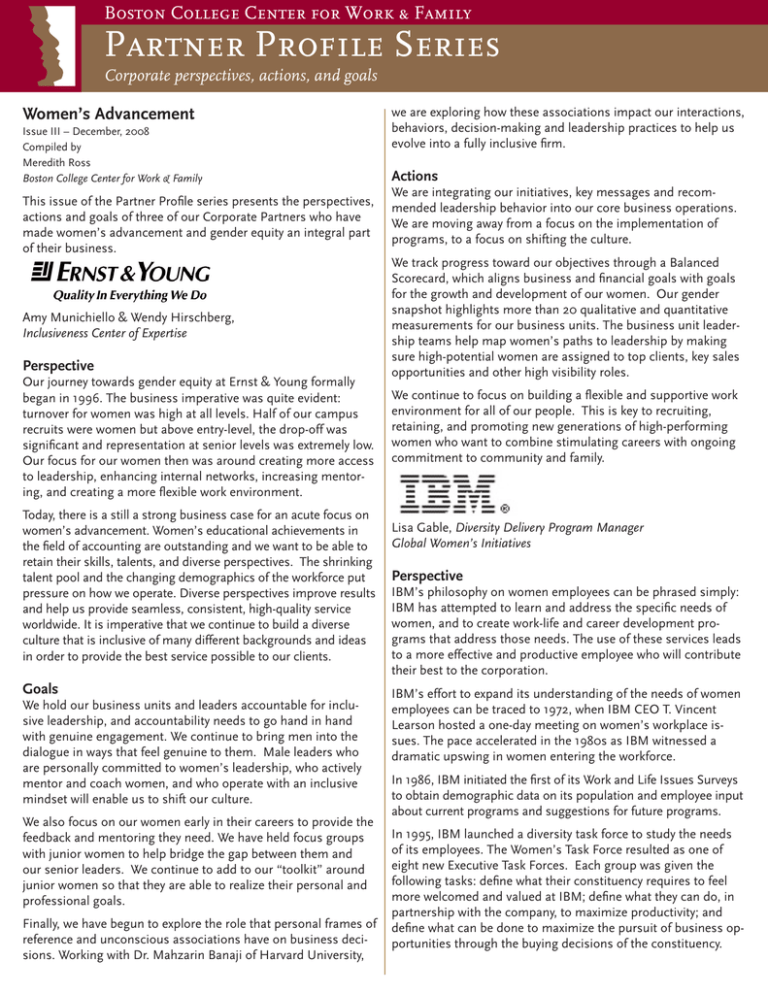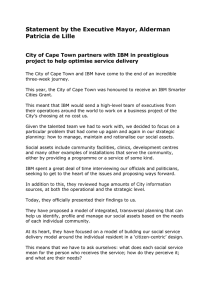Women’s Advancement
advertisement

Boston College Center for Work & Family Partner Profile Series Corporate perspectives, actions, and goals Women’s Advancement Issue III – December, 2008 Compiled by Meredith Ross Boston College Center for Work & Family This issue of the Partner Profile series presents the perspectives, actions and goals of three of our Corporate Partners who have made women’s advancement and gender equity an integral part of their business. Amy Munichiello & Wendy Hirschberg, Inclusiveness Center of Expertise Perspective Our journey towards gender equity at Ernst & Young formally began in 1996. The business imperative was quite evident: turnover for women was high at all levels. Half of our campus recruits were women but above entry-level, the drop-off was significant and representation at senior levels was extremely low. Our focus for our women then was around creating more access to leadership, enhancing internal networks, increasing mentoring, and creating a more flexible work environment. Today, there is a still a strong business case for an acute focus on women’s advancement. Women’s educational achievements in the field of accounting are outstanding and we want to be able to retain their skills, talents, and diverse perspectives. The shrinking talent pool and the changing demographics of the workforce put pressure on how we operate. Diverse perspectives improve results and help us provide seamless, consistent, high-quality service worldwide. It is imperative that we continue to build a diverse culture that is inclusive of many different backgrounds and ideas in order to provide the best service possible to our clients. Goals We hold our business units and leaders accountable for inclusive leadership, and accountability needs to go hand in hand with genuine engagement. We continue to bring men into the dialogue in ways that feel genuine to them. Male leaders who are personally committed to women’s leadership, who actively mentor and coach women, and who operate with an inclusive mindset will enable us to shift our culture. We also focus on our women early in their careers to provide the feedback and mentoring they need. We have held focus groups with junior women to help bridge the gap between them and our senior leaders. We continue to add to our “toolkit” around junior women so that they are able to realize their personal and professional goals. Finally, we have begun to explore the role that personal frames of reference and unconscious associations have on business decisions. Working with Dr. Mahzarin Banaji of Harvard University, we are exploring how these associations impact our interactions, behaviors, decision-making and leadership practices to help us evolve into a fully inclusive firm. Actions We are integrating our initiatives, key messages and recommended leadership behavior into our core business operations. We are moving away from a focus on the implementation of programs, to a focus on shifting the culture. We track progress toward our objectives through a Balanced Scorecard, which aligns business and financial goals with goals for the growth and development of our women. Our gender snapshot highlights more than 20 qualitative and quantitative measurements for our business units. The business unit leadership teams help map women’s paths to leadership by making sure high-potential women are assigned to top clients, key sales opportunities and other high visibility roles. We continue to focus on building a flexible and supportive work environment for all of our people. This is key to recruiting, retaining, and promoting new generations of high-performing women who want to combine stimulating careers with ongoing commitment to community and family. Lisa Gable, Diversity Delivery Program Manager Global Women’s Initiatives Perspective IBM’s philosophy on women employees can be phrased simply: IBM has attempted to learn and address the specific needs of women, and to create work-life and career development programs that address those needs. The use of these services leads to a more effective and productive employee who will contribute their best to the corporation. IBM’s effort to expand its understanding of the needs of women employees can be traced to 1972, when IBM CEO T. Vincent Learson hosted a one-day meeting on women’s workplace issues. The pace accelerated in the 1980s as IBM witnessed a dramatic upswing in women entering the workforce. In 1986, IBM initiated the first of its Work and Life Issues Surveys to obtain demographic data on its population and employee input about current programs and suggestions for future programs. In 1995, IBM launched a diversity task force to study the needs of its employees. The Women’s Task Force resulted as one of eight new Executive Task Forces. Each group was given the following tasks: define what their constituency requires to feel more welcomed and valued at IBM; define what they can do, in partnership with the company, to maximize productivity; and define what can be done to maximize the pursuit of business opportunities through the buying decisions of the constituency. The Women’s Task Force recommended: • Implement Employee Network Groups • Develop a Regular Part-time Employment Category • Integrate Work/life Flexibility into the Business Process • Enhance IBM’s focus in the Marketplace • Provide additional focus on Technical Women and Multicultural Women In March of 1997, IBM initiated The Women in Technology Steering Committee to address topics related to IBM’s relationship with women in technology both inside and outside the corporation. Its goals are to support the growth, development and recognition of IBM’s technical women, to attract and recruit technical women to IBM and to encourage girls and young women to pursue education and careers in science and technology. Goals • Ensure IBM is an employer of choice for women • Increase the contribution of and number of women throughout IBM • Enable a gender inclusive culture • Ensure the business case for gender diversity is embedded in and reflects IBM’s business focus Actions Through a series of global web seminars, teleconferences, newsletters and town hall events, women have benefited from skills development, career counseling, mentoring, and resources to manage work/life integration. Examples include “Taking the Stage,TM” a successful program to help IBM women gain a leadership presence, and Mindset workshops, which explore perceptions and create awareness of the differing experiences of men and women in IBM. Externally, IBM developed a structure to address women business owners as a unique market segment with tailored communications and market strategy. IBM has more than 40 Women’s Councils globally. We have implemented a regular part-time employment program, employee network groups (42 of the 209 are women’s groups) and the Global Partnership for Work/Life. The global woman’s leadership committee maintains IBM’s focus on achieving its goals as they pertain to the advancement of women. Jeffery Smith, Associate Director, Global Diversity & Inclusion Perspective At Procter & Gamble, there are three ways in which women’s advancement is a business issue. The first relates to consumer demographics. Women are very important to us as consumers – research shows that women make 80% of purchases in the household. As a pure business driver we seek insight into women as consumers and our workforce must be representative of that demographic. Our workforce must fuel our innovation in terms of creating and delivering the products, goods, and services that women as consumers will buy over and over again. A second consideration is our effort to be an employer of choice. We want to recruit and retain employees from all demographic groups, and to be viewed highly by all groups. Having women represented throughout the organization, and especially in critical leadership roles, helps P&G to position itself as a preferred employer. Our third business issue is the creation of an inclusive culture in the organization. It is important for women to see our company’s culture as one that is sensitive to their needs. P&G believes that a fully engaged and leveraged diverse workforce is a competitive advantage, and one that can be gained only by fostering an inclusive culture. Goals P&G’s main goal is straightforward and quantifiable: to have a representative number of women at all levels of the company, from entry level to the C-suite. One aspect of this is having hiring targets to bring women into the organization and to create a pipeline through which they can advance. Other goals are related to the business issues: to be viewed as an employer of choice, and to have an inclusive work environment around the globe. To determine our progress, we look at employee surveys, overall company numbers on employee metrics (representation, advancement, attrition, etc.), and some comparisons of demographic groups. Promoting inclusion means tracking our activities and progress relative to women, men, and all demographic groups. Actions Our Corporate Women’s Leadership Team, an affinity group led by senior women, is a sensing and mentoring organization which provides feedback to company leadership and receives it in return. The Team identifies needs of women that P&G may not be addressing, and also provides support. As women matriculate through the company, it is crucial for them to have support from others who have dealt with the same situations, such as managing issues of dual-earner couples, navigating child care problems, or making the most of a promotion. In 2007, we held an African-American Women’s summit focused on development and empowerment for women of color. The summit provided an opportunity to receive career advice from a diverse group of senior leaders (men, women, ethnically diverse, and many functions and levels of experience). Our focus on gender equity is global. One example is our work with country governments in the Middle East to ensure that women and men are able to work in close proximity at P&G, despite strict local laws. We began hiring female contractors in 1998 and, by negotiating with the Saudi department of labor, we helped establish systemic processes for female employment. We now have women working in secure environments with full benefits and robust career paths. We have also supported community education programs on how women can contribute to the business while still respecting cultural norms.





